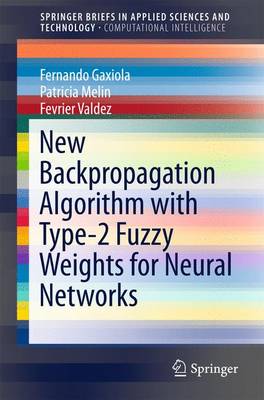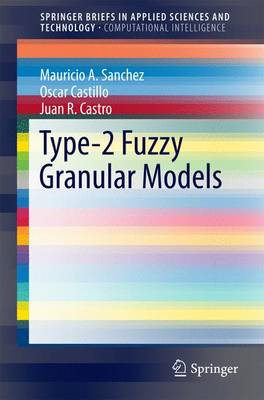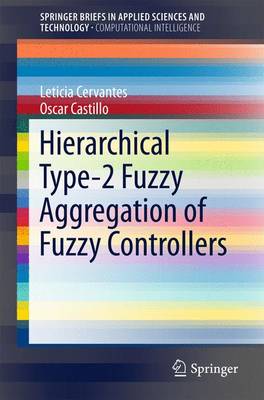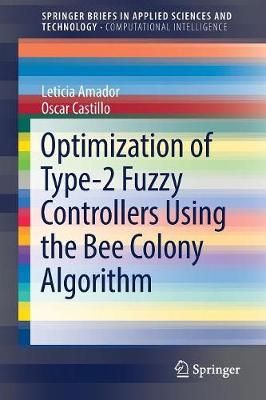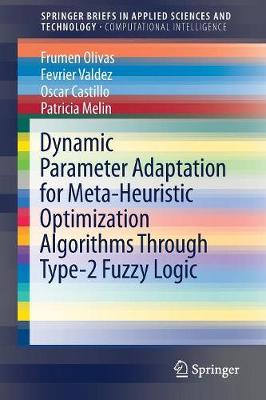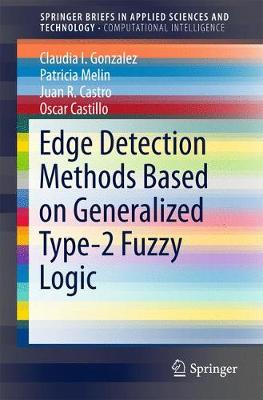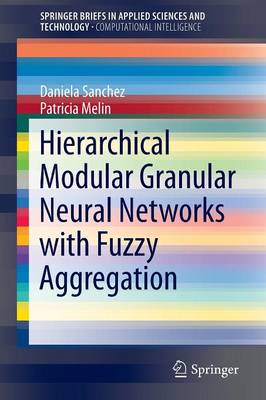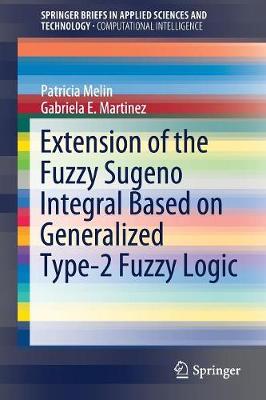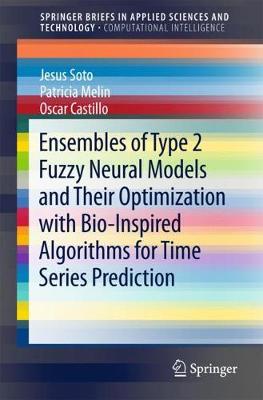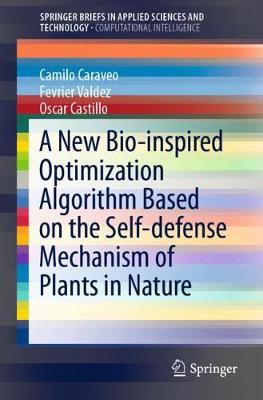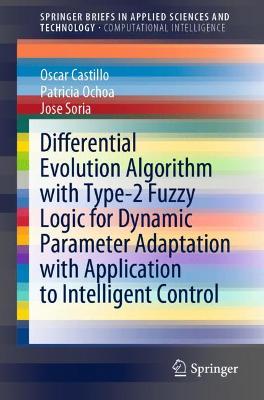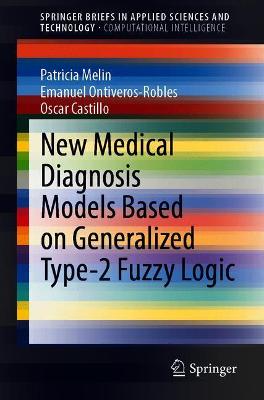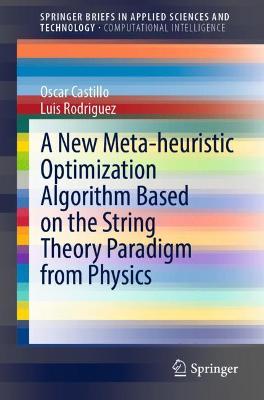SpringerBriefs in Computational Intelligence
13 total works
New Backpropagation Algorithm with Type-2 Fuzzy Weights for Neural Networks
by Fernando Gaxiola, Patricia Melin, and Fevrier Valdez
Type-2 Fuzzy Granular Models
by Mauricio A. Sanchez, Oscar Castillo, and Juan R. Castro
In this book, a series of granular algorithms are proposed. A nature inspired granular algorithm based on Newtonian gravitational forces is proposed. A series of methods for the formation of higher-type information granules represented by Interval Type-2 Fuzzy Sets are also shown, via multiple approaches, such as Coefficient of Variation, principle of justifiable granularity, uncertainty-based information concept, and numerical evidence based. And a fuzzy granular application comparison is given as to demonstrate the differences in how uncertainty affects the performance of fuzzy information granules.
Hierarchical Type-2 Fuzzy Aggregation of Fuzzy Controllers
by Leticia Cervantes and Oscar Castillo
This book focuses on the fields of fuzzy logic, granular computing and also considering the control area. These areas can work together to solve various control problems, the idea is that this combination of areas would enable even more complex problem solving and better results. In this book we test the proposed method using two benchmark problems: the total flight control and the problem of water level control for a 3 tank system. When fuzzy logic is used it make it easy to performed the simulations, these fuzzy systems help to model the behavior of a real systems, using the fuzzy systems fuzzy rules are generated and with this can generate the behavior of any variable depending on the inputs and linguistic value. For this reason this work considers the proposed architecture using fuzzy systems and with this improve the behavior of the complex control problems.
Optimization of Type-2 Fuzzy Controllers Using the Bee Colony Algorithm
by Leticia Amador and Oscar Castillo
Edge Detection Methods Based on Generalized Type-2 Fuzzy Logic
by Claudia I. Gonzalez, Patricia Melin, Juan R. Castro, and Oscar Castillo
Another contribution in this book is that the generalized type-2 fuzzy edge detector method is applied in the preprocessing phase of a face rec-ognition system; where the recognition system is based on a monolithic neural network. The aim of this part of the book is to show the advantage of using a generalized type-2 fuzzy edge detector in pattern recognition applications.
The main goal of using generalized type-2 fuzzy logic in edge detec-tion applications is to provide them with the ability to handle uncertainty in processing real world images; otherwise, to demonstrate that a GT2 FS has a better performance than the edge detection methods based on type-1 and type-2 fuzzy logic systems.
Hierarchical Modular Granular Neural Networks with Fuzzy Aggregation
by Daniela Sanchez and Patricia Melin
In this book, a new method for hybrid intelligent systems is proposed. The proposed method is based on a granular computing approach applied in two levels. The techniques used and combined in the proposed method are modular neural networks (MNNs) with a Granular Computing (GrC) approach, thus resulting in a new concept of MNNs; modular granular neural networks (MGNNs). In addition fuzzy logic (FL) and hierarchical genetic algorithms (HGAs) are techniques used in this research work to improve results. These techniques are chosen because in other works have demonstrated to be a good option, and in the case of MNNs and HGAs, these techniques allow to improve the results obtained than with their conventional versions; respectively artificial neural networks and genetic algorithms.
Extension of the Fuzzy Sugeno Integral Based on Generalized Type-2 Fuzzy Logic
by Patricia Melin and Gabriela E. Martinez
Ensembles of Type 2 Fuzzy Neural Models and Their Optimization with Bio-Inspired Algorithms for Time Series Prediction
by Jesus Soto, Patricia Melin, and Oscar Castillo
This book focuses on the fields of hybrid intelligent systems based on fuzzy systems, neural networks, bio-inspired algorithms and time series. This book describes the construction of ensembles of Interval Type-2 Fuzzy Neural Networks models and the optimization of their fuzzy integrators with bio-inspired algorithms for time series prediction. Interval type-2 and type-1 fuzzy systems are used to integrate the outputs of the Ensemble of Interval Type-2 Fuzzy Neural Network models. Genetic Algorithms and Particle Swarm Optimization are the Bio-Inspired algorithms used for the optimization of the fuzzy response integrators. The Mackey-Glass, Mexican Stock Exchange, Dow Jones and NASDAQ time series are used to test of performance of the proposed method. Prediction errors are evaluated by the following metrics: Mean Absolute Error, Mean Square Error, Root Mean Square Error, Mean Percentage Error and Mean Absolute Percentage Error. The proposed prediction model outperforms state of the art methods in predicting the particular time series considered in this work.
A New Bio-inspired Optimization Algorithm Based on the Self-defense Mechanism of Plants in Nature
by Camilo Caraveo, Fevrier Valdez, and Oscar Castillo
This book presents a new meta-heuristic algorithm, inspired by the self-defense mechanisms of plants in nature. Numerous published works have demonstrated the various self-defense mechanisms (survival strategies) plants use to protect themselves against predatory organisms, such as herbivorous insects. The proposed algorithm is based on the predator–prey mathematical model originally proposed by Lotka and Volterra, consisting of two nonlinear first-order differential equations, which allow the growth of two interacting populations (prey and predator) to be modeled. The proposed meta-heuristic is able to produce excellent results in several sets of benchmark optimization problems. Further, fuzzy logic is used for dynamic parameter adaptation in the algorithm.
This book focuses on the fields of fuzzy logic, bio-inspired algorithm, especially the differential evolution algorithm and also considering the fuzzy control area. The main idea is that these two areas together can help solve various control problems and to find better results. In this book, the authors test the proposed method using five benchmark control problems. First, the water tank, temperature, mobile robot, and inverted pendulum controllers are considered. For these 4 problems, experimentation was carried out using a Type-1 fuzzy system and an Interval Type-2 system. The last control problem was the D.C. motor, for which the experiments were performed with Type-1, Interval Type-2, and Generalized Type-2 fuzzy systems. When we use fuzzy systems combined with the differential evolution algorithm, we can notice that the results obtained in each of the controllers are better and with increasing uncertainty, the results are even better. For this reason, the authors consider in this book the proposed method using fuzzy systems and the differential evolution algorithm to improve the fuzzy controllers’ behavior in complex control problems.
New Medical Diagnosis Models Based on Generalized Type-2 Fuzzy Logic
by Patricia Melin, Emanuel Ontiveros-Robles, and Oscar Castillo
A New Meta-heuristic Optimization Algorithm Based on the String Theory Paradigm from Physics
by Oscar Castillo and Luis Rodriguez
This book focuses on the fields of nature-inspired algorithms, optimization problems and fuzzy logic. In this book, a new metaheuristic based on String Theory from Physics is proposed. It is important to mention that we have proposed the new algorithm to generate new potential solutions in optimization problems in order to find new ways that could improve the results in solving these problems. We are presenting the results for the proposed method in different cases of study. The first case, is optimization of traditional benchmark mathematical functions. The second case, is the optimization of benchmark functions of the CEC 2015 Competition and we are also presenting results of the CEC 2017 Competition on Constrained Real-Parameter Optimization that are problems that contain the presence of constraints that alter the shape of the search space making them more difficult to solve. Finally, in the third case, we are presenting the optimization of a fuzzy inference system, specifically for finding the optimal design of a fuzzy controller for an autonomous mobile robot. It is important to mention that in all study cases we are presenting statistical tests in or-der to validate the performance of proposed method. In summary, we believe that this book will be of great interest to a wide audience, ranging from engineering and science graduate students, to researchers and professors in computational intelligence, metaheuristics, optimization, robotics and control.
